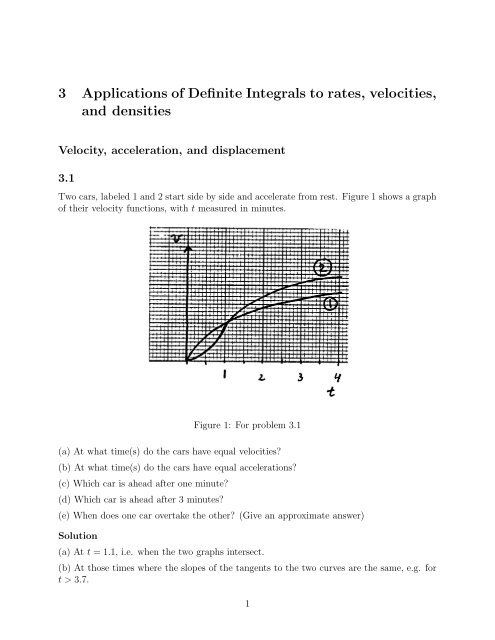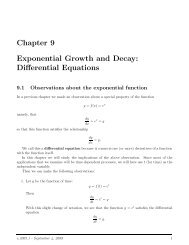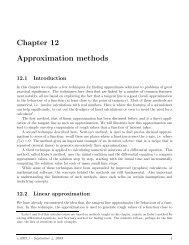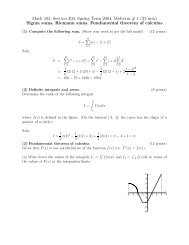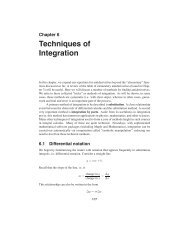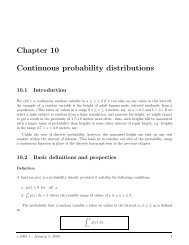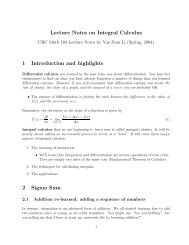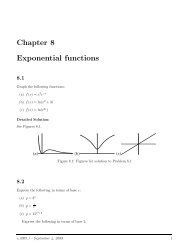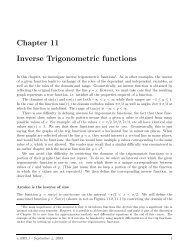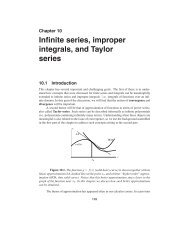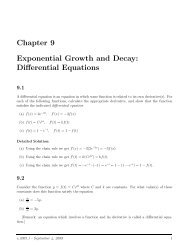3 Applications of Definite Integrals to rates, velocities, and densities
3 Applications of Definite Integrals to rates, velocities, and densities
3 Applications of Definite Integrals to rates, velocities, and densities
You also want an ePaper? Increase the reach of your titles
YUMPU automatically turns print PDFs into web optimized ePapers that Google loves.
(c) Car 1, because the area under the graph if its velocity between 0 <strong>and</strong> 1 is bigger thanthe corresponding area for car 2.(d) Car 2, because the area under the graph if its velocity between 0 <strong>and</strong> 3 is bigger thanthe corresponding area for car 1.(e) Car 2 overtakes car 1 at the point t at which the areas under the two velocity curvesfrom 0 <strong>to</strong> t are the same, i.e at ca. t = 2.3.3.2The speed <strong>of</strong> a car (km/h) in a chase scene is given by the expressionv(t) = 2t 2 − 5t, 0 < t < 10where t is time in minutes. Use this expression <strong>to</strong> find(a) The acceleration over this time period.(b) The <strong>to</strong>tal displacement over the same time period.Solution(a) Acceleration a(t) = d dt v(t) = d dt (2t2 − 5t) = 4t − 5, for 0 < t < 10.(b) Total displacement over 0 < t < 10 is3.3x(10) − x(0) ==∫ 10∫ 10v(t) dt =00( ) 2t3 ∣∣∣∣3 − 5t2 102= 200030− 250 = 12503(2t 2 − 5t) dt= 2(1000)3− 5(100)2≈ 416.7 kmThe velocity <strong>of</strong> a boat moving through water is found <strong>to</strong> be v(t) = 10(1 − e −t ).(a) Find the acceleration <strong>of</strong> the boat <strong>and</strong> show that it satisfies a differential equation, i.e anequation <strong>of</strong> the form d[a(t)]/dt = −k · a(t) for some value <strong>of</strong> the constant k (i.e. find thatvalue <strong>of</strong> k).(b) Find the displacement <strong>of</strong> the boat at time t.Solution(a) The acceleration <strong>of</strong> the boat isa(t) = dv(t)dt= 10e −t 2
at any time t = T, up <strong>to</strong> <strong>and</strong> including the time when the car comes <strong>to</strong> a halt. Thereforev(0) − v(T )100 × 1000T = . The initial velocity is v(0) = = 1000 m/sec, <strong>and</strong> so the time860 × 60 36100036it takes the car <strong>to</strong> s<strong>to</strong>p, once the brakes are applied, is T =− 0 ≈ 3.47 sec. Adding on8the reaction time, we see it takes 3.47 sec + 0.5 sec = 3.97 sec for the car <strong>to</strong> come <strong>to</strong> a fulls<strong>to</strong>p.3.7You are driving your car quickly (at speed 100 km/hr) <strong>to</strong> catch your flight <strong>to</strong> Hawaii formid-term break. A pedestrian runs across the road, forcing you <strong>to</strong> brake hard. Suppose ittakes you 1 sec <strong>to</strong> react <strong>to</strong> the danger, <strong>and</strong> that when you apply your brakes, you slow downat the rate a = −10 m/sec 2 . How long will it take you <strong>to</strong> s<strong>to</strong>p? How far will your car movefrom the instant that the danger is sighted until coming <strong>to</strong> a complete s<strong>to</strong>p?SolutionLet t = 0 be the time you hit the brakes, <strong>and</strong> t = T be the time that you s<strong>to</strong>p.100 kmYour velocity at t = 0 is · 1000 mh 1 km · 1 h3600 s = 1000 m36 s .The <strong>to</strong>tal time <strong>to</strong> s<strong>to</strong>p is the sum <strong>of</strong> the following times: (1 sec reaction time) + (time <strong>to</strong>slow down from 1000 → 0 m).36 sThe velocity is related <strong>to</strong> acceleration by:∫ ∫v(t) = a dt = (−10) dt = −10t + CAt time t = 0, v(0) = 100036m/s, so C = 100036<strong>and</strong>v(t) = −10t + 100036 .To find the time <strong>to</strong> slow down from 1000 m/s <strong>to</strong> 0m/s, we set t = T <strong>and</strong> v(T ) = 0, which36gives 1000100− 10T = 0 ⇒ T = sec ≈ 2.8 sec.36 36 (Therefore, the <strong>to</strong>tal time <strong>to</strong> s<strong>to</strong>p is 1 + 100 )sec ≈ 3.8 sec.36The(<strong>to</strong>tal distance traveled is equal <strong>to</strong> the following sum:1 sec at 1000 ) (36 m/s + distance traveled in T = 100)36 sec after brakingTo find the distance traveled after braking, we use the distance function (in meters), whichis related <strong>to</strong> velocity by:∫∫ (d(t) = v(t) dt = −10t + 1000 )36dt = −5t 2 + 100036 t + C5
3.9In ancient Egypt, most <strong>of</strong> the population was confined <strong>to</strong> the shores <strong>of</strong> the river Nile. Thedensity <strong>of</strong> the population decreased with increasing distance from the sea. Suppose that thepopulation density at distance x from the mouth <strong>of</strong> the river was p(x) = 200e −0.001x peopleper km, where x is distance in km.(a) What was the <strong>to</strong>tal population size along the first 100 km <strong>of</strong> the river?(b) What was the <strong>to</strong>tal population size along the whole length <strong>of</strong> the river?Solution(a) Let P (100) be the number <strong>of</strong> people that lived along the first 100 km. ThenP (100) =∫ 1000p(x) dx =∫ 1000100∣0200e −0.001x dx200=−0.001 [e−0.001x ] = 200 [e −0.001·100 − 1 ]−0.001= 200000[1 − e −0.1 ] = 19032.52 ∼ 19033 [people](b) Let P (L) be the number <strong>of</strong> people that lived along the entire length <strong>of</strong> the river. ThenP (L) =∫ L0p(x)dx =∫ L0200e −0.001x dxP (L) = 200−0.001 (e−0.001×L − 1).As L → ∞, e −0.001L → 0. So P (L) = 200 (−1) = 200000.−0.0013.10The air density h meters above the earth’s surface isp(h) = 1.28e −0.000124h (kg/m 3 )Find the mass <strong>of</strong> a cylindrical column <strong>of</strong> air 4 meters in diameter <strong>and</strong> 25 kilometers high.Let H = 25km = 25000m be the height, <strong>and</strong> let A = 1.28, a = −0.000124.SolutionThe <strong>to</strong>tal mass is M = 4π ∫ H0 p(h) dh = 4π ∫ ∣H∣∣∣0 Ae−ah dh = 4πA( e−ah ) H−a0123873.71kg.= 4πA 1−e−aH−a=7
3.11A test-tube contains a solution <strong>of</strong> glucose which has been prepared so that the concentration<strong>of</strong> glucose is greatest at the bot<strong>to</strong>m <strong>and</strong> decreases gradually <strong>to</strong>wards the <strong>to</strong>p <strong>of</strong> the fluid.(This is called a density gradient). Suppose that the concentration c as a function <strong>of</strong> thedepth x is c(x) = x/10 (in units <strong>of</strong> gm/cm 3 ). The radius <strong>of</strong> the tube is 2 cm 2 <strong>and</strong> the height<strong>of</strong> the glucose-containing solution is 10 cm. Determine the <strong>to</strong>tal amount <strong>of</strong> glucose in thetube (in gm).SolutionAssume a cylindrical tube <strong>and</strong> consider slicing it along its axis. The volume <strong>of</strong> such a sliceis πr 2 ∆x, <strong>and</strong> this small slice contains an amount πr 2 ∆x · c(x) <strong>of</strong> glucose. The integral wewant is3.12∫ 10∫ 10C = πr 2 c(x) dx = πr 2 (x/10)dx = (4π/10)(x 2 /2)| 10000= 20π gm.Suppose a lake has a depth <strong>of</strong> 40 meters <strong>and</strong> is bowl-shaped, with the surface <strong>of</strong> the bowlgenerated by rotating the curve z = x 2 /10 around the z-axis. Here z is height in metersfrom the bot<strong>to</strong>m <strong>of</strong> the bowl. The distribution <strong>of</strong> sediment in the lake is stratified by heightalong the water column. In other words, the density <strong>of</strong> sediment (in mass per unit volume)is a function <strong>of</strong> the form s(z) = C(40 − z), where z is again vertical height in meters fromthe point at the bot<strong>to</strong>m <strong>of</strong> the lake. Find the <strong>to</strong>tal mass <strong>of</strong> sediment in the lake. (Youranswer will have the constant C in it.)SolutionThe radius <strong>of</strong> a horizontal slice through the lake at height z is x = √ 10z. The volume <strong>of</strong> one<strong>of</strong> these slices is then V = πx 2 ∆z = π10z∆z. Therefore, the amount <strong>of</strong> sediment containedin a layer at height z from the bot<strong>to</strong>m isThe <strong>to</strong>tal amount <strong>of</strong> sediment is therefore∫ 400s(z) · V = s(z) · π10z∆z = 10πC(40 − z)z∆z.10πC(40 − z)z dz = [10πC(20z 2 − z33 )] ∣ ∣∣∣ 400≈ 335103C [mass units].8
3.13Rates <strong>of</strong> change <strong>and</strong> <strong>to</strong>tal changeThe growth rate <strong>of</strong> two children (in gm/day) is shown in Figure 3. Suppose both have thesame weight at time t = 0.Figure 3: For problem 3.13(a) Which one is larger after 6 months?(b) Which one is larger after 1 year?SolutionThe size (e.g. weight) <strong>of</strong> each child is represented by the area under the growth curve up <strong>to</strong>the given time.(a)After 6 months (0.5 year) the <strong>to</strong>p growth curve has largest accumulated area. (The largestchild)(b)After 1 year, the area under the second curve has overtaken the area under the first. (Thesecond child has gotten larger that the first.)3.14The flow rate <strong>of</strong> blood through the heart can be described approximately as a periodicfunction <strong>of</strong> the form F (t) = A(1 + sin(0.15t)), where t is time in seconds <strong>and</strong> A is a constantin units <strong>of</strong> cubic cm per second. (Thus, at time t, F (t) cubic cm <strong>of</strong> blood flow through theheart per second.) Find the <strong>to</strong>tal volume <strong>of</strong> blood that flows through the heart betweent = 0 <strong>and</strong> t = 1. (Express your answer in terms <strong>of</strong> A.)Solution9
If the rate <strong>of</strong> flow is F (t), then the <strong>to</strong>tal flow between times t = 0 <strong>and</strong> t = 1 is3.15I =∫ 10F (t)dt =∫ 10A(1 + sin(0.15t))dt1I = A(t − cos(0.15t)/0.15)∣0I = A(1 − cos(0.15)/0.15) − A(−1/0.15) = A(1.15/0.15 − cos(0.15)/0.15)During a gambling session lasting 6 hours, the rate <strong>of</strong> winnings at a casino in dollars perhour are seen <strong>to</strong> follow the formula w(t) = 2000t(1 − (t/6)). Find the <strong>to</strong>tal winnings duringthat whole session.SolutionThe <strong>to</strong>tal winnings are3.16∫ 60(2000t 1 − t ) ∣ ∣∣∣dt = 1000t 2 6− 2000 ∣ ∣∣∣ 660 18 t3 = 36000 − 24000 = 12000.0At time t, an intravenous infusion delivers a flow rate <strong>of</strong> y = 100(1 − t 3 ) cm 3 /hr, where t istime in hours. The infusion contains a drug at concentration 0.1 mg/cm 3 . Find the <strong>to</strong>talvolume <strong>of</strong> fluid <strong>and</strong> the <strong>to</strong>tal amount <strong>of</strong> drug delivered <strong>to</strong> the patient over a 1 hour periodfrom t = 0 <strong>to</strong> t = 1.SolutionThe <strong>to</strong>tal volume <strong>of</strong> fluid delivered isI =∫ 10y(t)dt =∫ 10100(1 − t 3 )dtI = 100(t − t 4 /4)| 1 0 = 75 cm3 .The <strong>to</strong>tal amount <strong>of</strong> drug delivered is 0.1 mg/cm 3 · 75 cm 3 = 7.5 mg.3.17Oil leaks out <strong>of</strong> an oil tanker at the rate f(t) = 10 − 0.2t 2 (where f is in 10 thous<strong>and</strong> barrelsper hour <strong>and</strong> t is in hours). (Note: This function only makes sense as long as f(t) ≥ 0 sincea negative flow <strong>of</strong> oil is meaningless in this case.)(a) At what time will the flow be zero?10
(b) What is the <strong>to</strong>tal amount that has leaked out between t = 0 <strong>and</strong> the time you found in(a)?Solution(a) The flow will be zero when f(t) = 0, i.e. 10 − 0.2t 2 = 0 ⇒ t 2 = 50 at t = 5 √ 2 [hr].(b) The <strong>to</strong>tal amount <strong>of</strong> oil that has leaked out between t = 0 <strong>and</strong> t = 5 √ 2 is found as:3.18F (t) = (10t − 0.23 t3 )∣F (5 √ 2) − F (0) =5 √ 20∫ 5√20f(t) dt =∫ 5√20(10 − 0.2t 2 ) dt= 50 √ 2 − 0.2 × (5 √ 2) 3 /3 = 47.14 × 10 thous<strong>and</strong> barrels.After a heavy rainfall, the rate <strong>of</strong> flow <strong>of</strong> water in<strong>to</strong> a lake is found <strong>to</strong> satisfy the relationship( ) t 2F (t) = 4 −10 − 1 where t is time in hours, 0 < t < 30 <strong>and</strong> F is in units <strong>of</strong> 100,000gallons/hr.(a) Find the time, t 1 at which the rate <strong>of</strong> flow is greatest.(b) Find the time, t 2 at which the flow is zero.(c) Find how much water in <strong>to</strong>tal has flowed in<strong>to</strong> the lake between these two times.Solution( ) t(a) F ′ (t) = −210 − 1 × 110 = 0 ⇐⇒ t = 10. Since F ′′ (t) = − 1 < 0 this value <strong>of</strong> t gives50the maximum rate <strong>of</strong> flow.( ) t 2(b) The flow is zero when F (t) = 0, ie. 4 −10 − 1 = 0 ⇒ t 2 = 30.(c) The <strong>to</strong>tal water flowing in<strong>to</strong> the lake between these times is∫ ( 30 ( ) ) t 2 4 −10 10 − 1 30dt = 4t∣ − 10 ( ) t 3 ∣ ∣∣∣3 10 − 1 30= 160 × 100 000 gallons.33.1910The growth rate <strong>of</strong> a crop is known <strong>to</strong> depend on temperature during the growing season.Suppose the growth rate <strong>of</strong> the crop in <strong>to</strong>ns per day is given by g(t) = 0.1(T (t) − 18) whereT (t) is temperature in degrees Celsius. Suppose the temperature record during the 90 days<strong>of</strong> the season was T (t) = 22 + 0.1t + 4 sin(2πt/60) where t is time in days. Find the <strong>to</strong>talgrowth (in <strong>to</strong>ns) that would have occurred over the whole season.Solution1110
The <strong>to</strong>tal growth <strong>of</strong> crop in 90 days is given as:G(90) − G(0) =∫ 900g(t) dt =∫ 900(0.1(T (t) − 18)) dt∫ 90G(t) = 0.1 (22 + 0.1t + 4 sin(2πt/60) − 18) dt = 0.1(4t + 0.102 t2 − 4 · 60∣ ∣∣∣2π cos(2πt/60)) 900G(t) = 0.1(360 + 405 − 120 (cos(3π) − cos(0))) = 0.1(765 + 240/π) = 84.1394 <strong>to</strong>nsπ3.20This question concerns cumulative exposure <strong>to</strong> radiation experienced by people living nearnuclear waste disposal sites.(a) Recall from last term that radioactive material decays according <strong>to</strong> a negative exponential:m(t) = m 0·e −rt , where m(t) is the mass <strong>of</strong> the radioactive material at time t, m 0 = m(0)is the initial mass at time t = 0, <strong>and</strong> r is the rate <strong>of</strong> decay. The half-life is the time it takesfor the material <strong>to</strong> decay <strong>to</strong> one half its initial mass. Suppose that t is measured in months.Determine the rate <strong>of</strong> decay r if the half-life is 1 month.(b) Assume that at any time, the amount <strong>of</strong> radiation is proportional <strong>to</strong> the mass <strong>of</strong> theradioactive material. If initially the radiation level is 0.5 rads per month, how could wedescribe the radiation level as a function <strong>of</strong> time?(c) Assume now that there is radioactive material in your backyard <strong>of</strong> the type consideredin (a) above, i.e. that it has a half-life <strong>of</strong> one month. Calculate the cumulative exposure inrads that would occur if you lived in your house for 10 years.Solution(a) Since the half-life is 1 month, t = 1, <strong>and</strong> we get from the formula for m(t): m o /2 =m o e −r ⇒ 0.5 = e −r ⇒ r = ln(2).(b) The amount <strong>of</strong> radiation R(t) is proportional <strong>to</strong> the mass <strong>of</strong> radioactive material. Nowwe know from (a) thatm(t) = m o e − ln(2)t .So,And finally, R(t) ≈ 0.5e −ln(2)t [rads].R(t) ≈ m(t) = m o e − ln(2)t ,0.5 = R(0) ≈ m o e − ln(2)×0 = m o .(c) Cumulative exposure in 10 years (120 months) is:∫ 12000.5e ln(2)t dt = 0.5− ln(2) e− ln(2)t ∣ ∣∣∣ 1200= 0.5ln(2) (1 − e−120 ln(2) ) = 0.7213 [rads].12
Figure 5: For problem 3.22In a short time interval dt, amount flowing in is I(t) dt, amount flowing out is O(t) dt, <strong>and</strong>the <strong>to</strong>tal change is I(t) dt − O(t) dt = [I(t) − O(t)] dt.(a) Let Q(t) be the <strong>to</strong>tal amount <strong>of</strong> water, t = 0 corresponds <strong>to</strong> start <strong>of</strong> the year.Q(T ) − Q(0) = <strong>to</strong>tal change over interval [0, T ] = sum <strong>of</strong> small changes = ∫ T0 [I(t) − O(t)] dt(b) Maxima <strong>and</strong> minima occur at critical points Q ′ (t) = 0. By the Fundamental Theorem<strong>of</strong> Calculus, Q ′ (t) = I(t) − O(t). Now Q ′ (t) = 0 ⇒ I(t) = O(t).At critical point A (see Figure 6), if t < A, I(t) > O(t) ⇒ Q ′ (t) > 0 ⇒ Q increases.For A < t < B, O(t) > I(t) ⇒ Q ′ (t) < 0 ⇒ Q decreases.Hence, A is the maximum, B is the minimum.Figure 6: For problem 3.22 solution3.23The rate at which animals migrate in<strong>to</strong> <strong>and</strong> out <strong>of</strong> a wildlife reserve is described by tw<strong>of</strong>unctions shown in Figure 7. I(t) is the rate at which animals enter the reserve <strong>and</strong> O(t) isthe rate at which they leave (both in number per day).(a) Express the number <strong>of</strong> animals in the reserve as a definite integral.(b) When is the number <strong>of</strong> animals in the reserve greatest <strong>and</strong> when is it smallest?Solution14
££££££££££££££££££££££££f(x)f*¡¡¡¡¡¡¡¡¡¡¡¢¡¢¡¢¡¢¡¢¡¢¡¢¡¢¡¢¡¢¡¢¡¢¡¢¡01x3.25Figure 9:During a particularly soggy week in Vancouver, rainfall reached epic proportions. The rainfallpattern was as follows: A constant 20mm on the first 24 hrs, a steady increase from 20 up<strong>to</strong> 50 mm over the next 24 hrs (assume linear increase), 50mm rain over the next 24 hrs, asteady drop from 50 down <strong>to</strong> 40 mm over the next 24 hrs, <strong>and</strong> a flat 30 mm over the next24 hrs. Determine the <strong>to</strong>tal amount <strong>of</strong> rain during this period <strong>and</strong> the average daily rainfallfor the same period.SolutionSee Figure 10.5rainfall (in cm)4321constant rate20mm/dayA2A1A3A4A51 2 3 4 5daysFigure 10: For problem 3.25 solutionTotal amount <strong>of</strong> rain = A 1 + A 2 + A 3 + A 4 + A 5= (2 + 7 2 + 5 + 9 5 + 3)16
= 18 cmAverage rainfall over 5 days =18 cm <strong>to</strong>tal5 days= 3.6 cm/day.3.26 [98 Final]Find the average value <strong>of</strong> the function f(x) = sin( πx ) over the interval [0,2].2Solution3.27¯f = 1 ∫ 2sin2 − 0 0( ) πxdx = 1 2 2( ) [ −2cosπ(a) Find the average value <strong>of</strong> x n over the interval [0, 1].( )] ∣ πx ∣∣∣ 2= −12 0 π (−1 − 1) = 2 π(b) What happens as n becomes arbitrarily large (that is, n → ∞)?(c) Explain your answer <strong>to</strong> part (b) by considering the graphs <strong>of</strong> these functions.(d) Repeat parts (a) - (c) using the functions x 1/n .Solution(a) Let f(x) = x n ,f avg = 1 ∫ 1x n dx = xn+11∣1 − 0 0 n + 1 0(b) As n → ∞, f avg → 0.= 1 , for n ≠ −1n + 1(c) See Figure 11.As n → ∞, the area under the curve in the interval [0, 1] gets smaller <strong>and</strong> smaller.(d) Let g(x) = x 1/n ,g avg = 1 ∫ 1x 1/n dx = x1/n+11∣ = 11for n ≠ −11 − 0 01/n + 1 0 + 1,nAs n → ∞, g avg → 1. See Figure 12.As n → ∞, the area under the curve in the interval [0, 1] gets closer <strong>to</strong> 1.17
yyy = xy = x 21x1xyyy = x 3y = x 41x1xFigure 11: For problem 3.27 (c) solutionyyy = xy = x 1/21x1xyyy = x 1/3y = x 1/41x1xFigure 12: For problem 3.27 (d) solution18
3.28An object starts from rest at t = 0 <strong>and</strong> accele<strong>rates</strong> so that a = dvdt = ce−t where c is a positiveconstant.(a)Find the average velocity over the first t seconds.(b)What happens <strong>to</strong> this average velocity as t becomes very large?Solutiona = dv = ce −t . v(0) = 0 since the object starts from rest. v = ∫ ∣t∣∣∣dt0 ce−t dt = −ce −t t0−c(e −t − e−0) = c(1 − e −t ) Therefore, velocity at anytime t is v(t) = c(1 − e −t )(a) Average velocity after first t seconds:∫1 tv(s) ds = 1 ∫ tt 0t c (1 − e −s )ds0= c t (s + te−s )∣0= c t (t + e−t − 0 − e −0 )= c t (t + e−t − 1)== C(1 + e−tt− 1 t )(b)When t → ∞, average velocity → C3.29 Symmetry(a) Find the average value <strong>of</strong> the function sin x over the interval [−π, π].(b) Find the average value <strong>of</strong> the function x 3 over the interval [−1, 1].(c) Find the average value <strong>of</strong> the function x 3 − x over the interval [−1, 1].(d) Explain these results graphically.(e) Find the average value <strong>of</strong> an odd function f(x) over the interval [−a, a]. (Remember thatf(x) is odd if f(−x) = −f(x).)(f) Suppose now that f(x) is an even function (that is, f(−x) = f(x)) <strong>and</strong> its average valueover the interval [0, 1] is 2. Find its average value over the interval [−1, 1].Solution(a)∫1 πsin x dx = 1 ∣ ∣∣∣π − (−π) −π 2π (− cos x) π= − 1 (1 − 1) = 0−π 2π19
yy = sin xyy = x 3−π π X−1 1 Xyy = x 3 −x−1 1XFigure 13: For problem 3.29 (e) solution(b)∫1 1x 3 dx = 1 1 − (−1) −1 2x 441∣ = 1 (1 4 − (−1) 4) = 0−1 8(c)∫1 11 − (−1) −1(x 3 − x) dx = 1 2( x44 − x22) ∣∣∣∣ 1= 1 ( 1−1 2 4 − 1 2 − 1 4 + 1 )= 02(d) See Figure 13. All these graphs are symmetric about the origin, so that the integral∫ 0−π sin x dx = − ∫ π0 sin x dx <strong>and</strong> they cancel out (similarly for the other two functions).(e) Odd function (symmetric about the origin): f(−x) = f(x).∫1 af(x) dx = 1 ∫ af(x) dx = 1 [∫ 0∫ a ]f(x) dx + f(x) dxa − (−a) −a 2a −a 2a −a0Now, let x = −u, then dx = −du, x = −a ⇒ u = a etc.∫ 0−af(x) dx = −= −== −∫ 0a∫ 0a∫ 0a∫ af(−u) du(−f(u)) du ⇒ since f is oddf(u) du = −0∫ a0f(u) du reversing limits <strong>of</strong> integrationf(x) dx since u is just a “dummy ′′ variable <strong>of</strong> integration20
Therefore,∫ 0−af(x) dx +∫ a0∫ a∫ af(x) dx = − f(x) dx + f(x) dx = 000Thus, the average value <strong>of</strong> an odd function over a symmetric interval [−a, a] is 0.(f) We are given that f(x) is an even function (that is, f(−x) = f(x)) <strong>and</strong> its average valueover the interval [0, 1] is 2. This means that¯f [0,1] = 1 1∫ 10f(x) dx =The average value over the interval [−1, 1] is¯f [−1,1] =∫ 10f(x) dx = 2∫1 1f(x) dx = 1 ∫ 1∫ 1(1 − (−1)) −1 2 · 2 f(x) dx = f(x) dx = ¯f [0,1]00(We have used the symmetry <strong>of</strong> the function here: the definite integral <strong>of</strong> an even functionover a symmetric interval about the y-axis will be double the value <strong>of</strong> the definite integralover half that interval.) Thus¯f [−1,1] = ¯f [0,1] = 2.3.30The intensity <strong>of</strong> light cast by a street lamp at a distance x (in meters) along the street fromthe base <strong>of</strong> the lamp is found <strong>to</strong> be approximately I(x) = 20 − x 2 in arbitrary units for−20 < x < 20.(a) Find the average intensity <strong>of</strong> the light over the interval −5 < x < 5.(b) Find the average intensity over −7 < x < 7.(c) Find the value <strong>of</strong> b such that the average intensity over [−b, b] is I av = 10.SolutionThe intervals <strong>and</strong> the function are symmetric, so∫1 aI av =(20 − x 2 ) dx = 1 ∫ aa − (−a) −a2a (2) (20 − x 2 ) dx = 1 ( ) ∣∣∣∣20x − x3 a0a 3 0(a) I av = 1 ∫ 55 0 (20 − x2 ) dx = 1 53[100 − ] = 35.5 3 3(b) I av = 1 ∫ 77 0 (20 − x2 ) dx = 1 73[140 − ] = 11.7 3 3(c) Solve 10 = 1 ∫ bb 0 (20−x2 ) dx for b. Integrating the right h<strong>and</strong> side gives 1[20b− b3 ] = 20− b2 .b 3 3Setting this equla <strong>to</strong> the left h<strong>and</strong> side gives b = √ 30 ≈ 5.477 meters.21
3.31The length <strong>of</strong> time from sunrise <strong>to</strong> sunset (in hours) t days after the Spring Equinox is givenby( ) πtl(t) = 12 + 4 sin182(a) Explain the meaning <strong>of</strong> the word “Equinox” <strong>and</strong> describe what happens on that dayaccording <strong>to</strong> the above formula.(b) What is the length <strong>of</strong> the shortest <strong>and</strong> the longest day <strong>and</strong> when do these occur according<strong>to</strong> this formula?(c) How long is one complete cycle in this expression?(d) Sketch l(t) as a function <strong>of</strong> t.(e) Find the average day-length over the month immediately following the Equinox.(f) Find the average day length over the whole year.geometric or intuitive argument.Solution( ) πtl(t) = 12 + 4 sin182Explain your result with a simple(a) Equinox is a time <strong>of</strong> year when the length <strong>of</strong> “day” (sunrise → sunset) equals the length<strong>of</strong> “night” (sunset → sunrise). This happens twice a year, once in spring <strong>and</strong> once in fall.On the Equinox, l(t) = 12 hours( ) πt⇒ 12 = 12 + 4 sin182⇒ t = 0 (Spring Equinox) or t = 182 (Fall Equinox)(b) We know that −1 ≤ sin ( ) ( )πt182 ≤ 1. So the longest day will occur when sin πt182 = 1 <strong>and</strong>the shortest day will occur when sin ( )πt182 = −1.Longest day( ) πtsin = 1 ⇒ πt182 182 = π 2 ⇒ t = 91l(91) = 12 + 4 · 1 = 16 hours, occurs 91 days after the Spring Equinox.Shortest day( ) πtsin = −1 ⇒ πt182 182 = 3π 2 ⇒ t = 27322
l(273) = 12 + 4(−1) = 8 hours, occurs 273 days after the Spring Equinox.(c) One complete cycle is 2(182) = 364 days, from this expression:sin(ωt) has frequency ω ⇒ ω cycles in every 2π.Therefore the length <strong>of</strong> one cycle = 2π ω = 2ππ/182 = 364.(d) See Figure 14.161412Spring EquinoxFall Equinox10l(t)hours864200 91 182 273 364tdaysFigure 14: For problem 3.31 (d)(e) Average day-length over 1st month after Spring Equinox (assume 30 days in month):l avg = 1 ∫ 30l(t) dt = 1 ∫ 30 (( )) πt12 + 4 sin dt30 0 30 0182= 1 (12t − 4 · 182 ( )) ∣ πt ∣∣∣ 30cos30 π 182 0= 1 [12 · 30 − 4 · 182 ( ) π · 30cos + 4 · 182 ]cos 030π 182 π= 12 − 364 ( ) 15π15π cos + 364 ≈ 13 hours91 15π(f) Average day length over whole year: (expect ≈ 12 hours)l avg = 1 ∫ 365l(t) dt365 0= 1365(12t − 4 · 182π( πtcos182)) ∣ ∣∣∣ 3650( π · 365182= 1 [12 · 365 − 4 · 182 cos365π= 12 − 728 ( ) 365π365π cos + 728182 365π= 12.0009 (≈ 12, as expected))+ 4 · 182 ]πFrom the graph in (d), we can see that over 364 days (almost a year) the average value <strong>of</strong>l(t) is 12 hours.23
3.32Consider the periodic function,f(t) = sin (2t) + cos (2t)(a) What is the frequency, the amplitude, <strong>and</strong> the length <strong>of</strong> one cycle in this function?Consider A sin(ωt + ϕ), A = amplitude, ϕ = phase shift, ω = frequency.A sin(ωt + ϕ) = A(sin(ωt) cos ϕ + cos(ωt) sin ϕ)(b) How would you define the average value <strong>of</strong> this function over one cycle ?(c) Compute this average value <strong>and</strong> show that it is zero. Now explain why this is true usinga geometric argument.Solution(a) Consider A sin(ωt + ϕ), A = amplitude, ϕ = phase shift, ω = frequency.If ϕ = π 4A sin(ωt + ϕ) = A(sin(ωt) cos ϕ + cos(ωt) sin ϕ)<strong>and</strong> ω = 2, thenA sin(2t + π 4 ) = A (sin(2t) ·)11√ + cos(2t) · √2 2If A = √ 2, then√ π 2 sin(2t + ) = sin(2t) + cos(2t) = f(t)4Therefore, frequency ω = 2 (meaning 2 cycles in length 2π), amplitude A = √ 2, length <strong>of</strong>one cycle = 2π/2 = π.(b) Average value <strong>of</strong> f(t) over one cycle:(c)f avg =1(length <strong>of</strong> cycle)∫ length0f(t) dt = 1 πf avg = 1 [− cos(2t) + sin(2t) ] ππ 2 20= 1 [(− 1 )π 2 + 0 −(− 1 )]2 + 0= 0∫ π0(sin(2t) + cos(2t)) dt(cos(2π) = 1, cos 0 = 1, sin(2π) = 0, sin 0 = 0.)See Figure 15. Over one cycle, there is equal amount <strong>of</strong> area above the x-axis as below thex-axis, so the average value <strong>of</strong> the function over one cycle is 0.24
2 1/2−π/8Figure 15: For problem 3.323.33The current in an AC electric circuit is given byI(t) = A cos(ωt)The power in the circuit is defined as P (t) = I 2 (t).(a) What is meant by one cycle in this situation?(b) Sketch graphs <strong>of</strong> I(t) <strong>and</strong> P (t). Explain why P (t) is always positive, <strong>and</strong> indicate howits zeros are related <strong>to</strong> zeros <strong>of</strong> I(t). What are the maximal <strong>and</strong> minimal values <strong>of</strong> each <strong>of</strong>these functions?(c) Find the average power <strong>and</strong> the average current over half a cycle. (Note: in computingthe average power, you will need <strong>to</strong> use the trick cos 2 (ωt) = 1 (1 + cos(2ωt))).2Solution(a) One cycle in this situation is one period (max <strong>to</strong> max or min <strong>to</strong> min) in the currentfunction I(t) = A cos(ωt).The frequency is ω so the period (i.e. the length <strong>of</strong> one cycle) is 2π ω .This length is equivalent <strong>to</strong> two periods (but one cycle) <strong>of</strong> the power function. The power isusing double-angle formula.( )1 + cos(2ωt)P (t) = I 2 (t) = A 2 cos 2 (ωt) = A 2 2P (t) = A22(b) See Figure 16.P (t) ≥ 0 since it is the square <strong>of</strong> I(t).(1 + cos(2ωt))25
I(t)P(t)AA 2 π / ω t2π / ωt−AFigure 16: For problem 3.33I(t) = 0 ⇒ cos(ωt) = 0⇒ ωt = π 2 , 3π2 , . . .⇒ t = π2ω , 3π2ω , . . .P (t) = 0 ⇒ I 2 (t) = 0 ⇒ I(t) = 0⇒ t = π2ω , 3π2ω , . . .Therefore, I(t) <strong>and</strong> P (t) have the same zeroes.Maximal <strong>and</strong> minimal values: −A ≤ I(t) ≤ A, 0 ≤ P (t) ≤ A 2 .The amplitude <strong>of</strong> I(t) is A, <strong>and</strong> thus it fluctuates between a maximum <strong>of</strong> A <strong>and</strong> a minimum<strong>of</strong> −A.Because P (t) is the square <strong>of</strong> I(t), it must always be greater than 0, which is therefore itsminimum. Its maximum is A 2 , the square <strong>of</strong> the amplitude <strong>of</strong> I(t).(c) Average power over a half cycle: (cycle length is 2π ω )P avg = ω π= ω π= ωA22π= ωA22π∫ π/ω0∫ π/ω0[P (t) dt = ω πA 22∫ π/ω(1 + cos(2ωt)) dtt + sin(2ωt)2ω0[ ] πω + 0 − 0 = A22 watts0] π/ωI avg = ω πA 2 cos 2 (ωt) dt∫ π/ω026I(t) dt
= ω π∫ π/ω0A cos(ωt) dt= ωA ∣ π∣∣∣πω sin(ωt) ω= A (0 − 0) = 0π0watts, as expected.27


